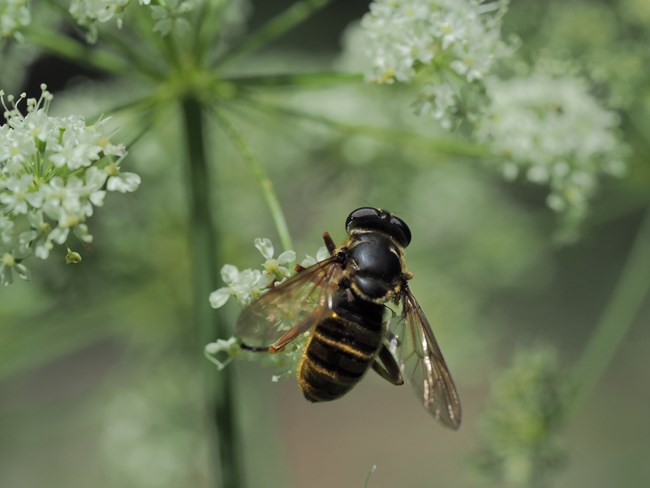
NPS photos/M Gorman and L Powell
Invertebrates live in water, land, and air, and they are found at all elevations throughout the park. Invertebrates exist in every location from the highest peaks, through the fastest flowing streams, in the deepest snow, and in the oldest forests. They are essential to thriving healthy ecosystems. 
NPS photo M Gorman ArthropodsArthropods are one group of invertebrates that are the most dominant at Crater Lake National Park. Arthropods are animals that have a hard outer shell known as the exoskeleton, segmented bodies, and jointed appendages (i.e. legs and antennae).The animal phylum Arthropoda (meaning jointed leg) hosts over 75% of the world’s known animals. At Crater Lake this includes many types of invertebrates which visitors may observe at home such as spiders, butterflies and moths, beetles, dragonflies, flies, grasshoppers, and ants. Invertebrates Are Mostly Good but Sometimes BadThe volcanic soils of Crater Lake National Park host many different arthropod species. These tiny animals living in and on the soil decomposing dead plant and animal material, turning it into nutrients. Arthropods are also an important food source for many bird, amphibian, and fish species whose diets mostly consist of arthropods. And then there are those like butterflies and bees that pollinate a variety of plants, which is a huge role in plant species survival.But, invertebrates can have a significant impact that can change an entire ecosystem of an area. Warming temperatures allow the mountain pine beetle to reproduce multiple times a year. When in abundance, this species causes trees to die, changing the structure of the forest within the park. A significant amount of beetle damage is visible throughout the forests, especially in the highest elevations among whitebark pines. Signal crayfish (Pacifastacus leniusculus klamathensis), invertebrates called crustaceans, were introduced in 1915 as food for fish which were stocked in the lake between 1896 and 1940. With the absence of predators other than rainbow trout, crayfish have expanded their habitat to occupy 80% of the shoreline. The ever-increasing number of crayfish continue to predate upon and reduce the amphibian populations in the lake. This includes a major decline in the Mazama newt, the largest native animal in the lake. The newt and other amphibians may one day be eliminated if a solution to crayfish expansion is not found. Still LearningCrater Lake does not have a thorough inventory of invertebrates. Several projects have been completed to begin understanding the species within the park. A butterfly bioblitz was completed in 2014. More intensive Lepidoptera (butterfly and moth) surveys were completed by Tilden and Huntzinger in 1970, and by Ross in 2015 and 2019.The galleries below introduce some of the invertebrates that live in the park but are far from inclusive. A few of the arthropods in these photo may not have a species name given as they are pending further identification. |
Last updated: October 27, 2021
